UMKC8T: Strategic Marketing Planning Report, Bristol University
VerifiedAdded on 2022/09/10
|15
|4293
|19
Report
AI Summary
This report provides a strategic marketing plan for Hopkinson's Coffee Company, a Bristol-based coffee company facing challenges in a competitive market. The report begins with a situation analysis, examining macro, meso, and micro factors, including political, economic, social, technological, legal, and environmental aspects. It then presents a SWOT analysis, identifying the company's strengths, weaknesses, opportunities, and threats. Based on this analysis, the report recommends specific marketing objectives, core strategies (promotional, pricing, and product), and segmentation, targeting, and positioning strategies. The report also includes a discussion of marketing mix decisions and concludes with a critical reflection on the chosen frameworks. The report aims to provide actionable recommendations to foster a strong market capitalization for Hopkinson's Coffee Company.
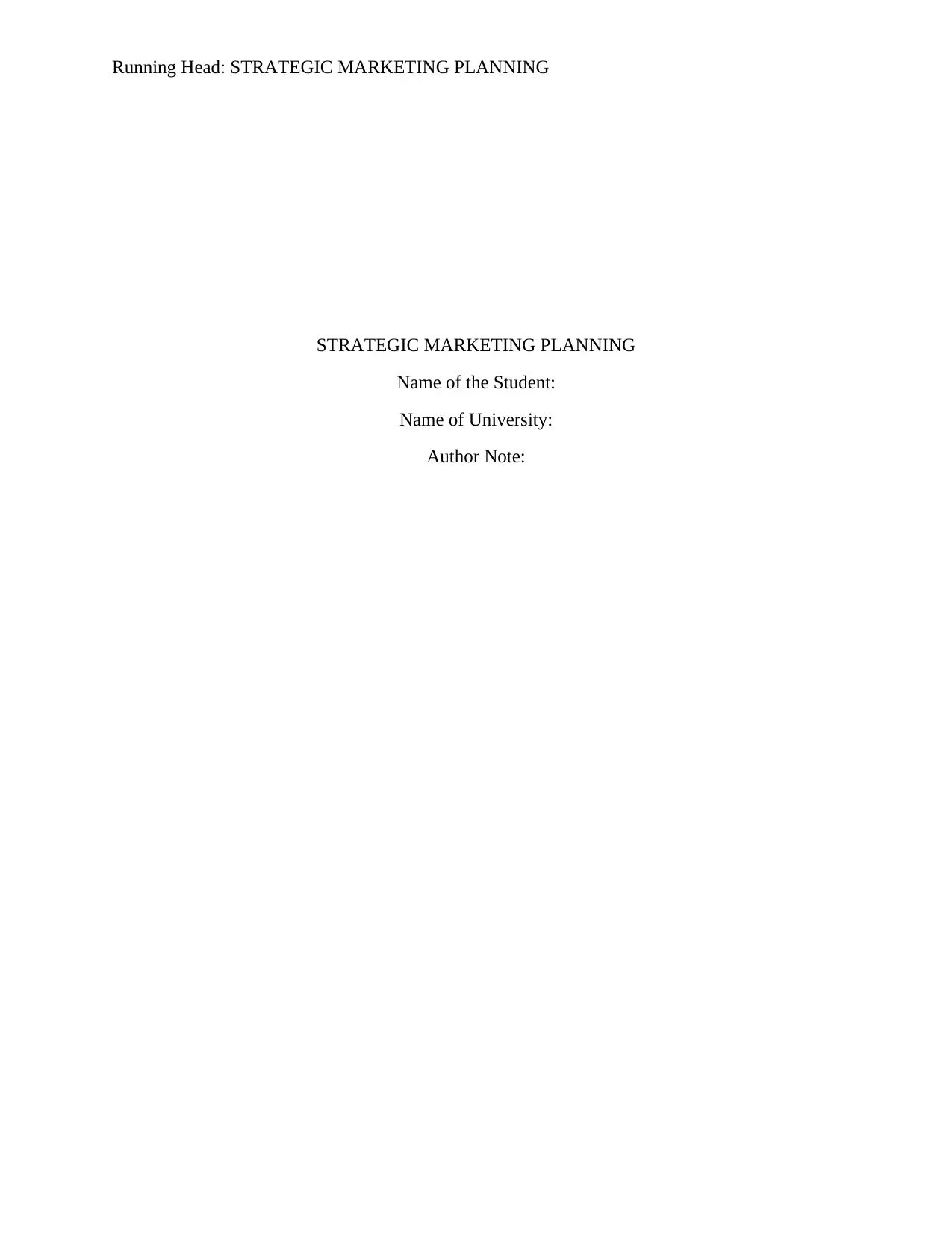
Running Head: STRATEGIC MARKETING PLANNING
STRATEGIC MARKETING PLANNING
Name of the Student:
Name of University:
Author Note:
STRATEGIC MARKETING PLANNING
Name of the Student:
Name of University:
Author Note:
Paraphrase This Document
Need a fresh take? Get an instant paraphrase of this document with our AI Paraphraser
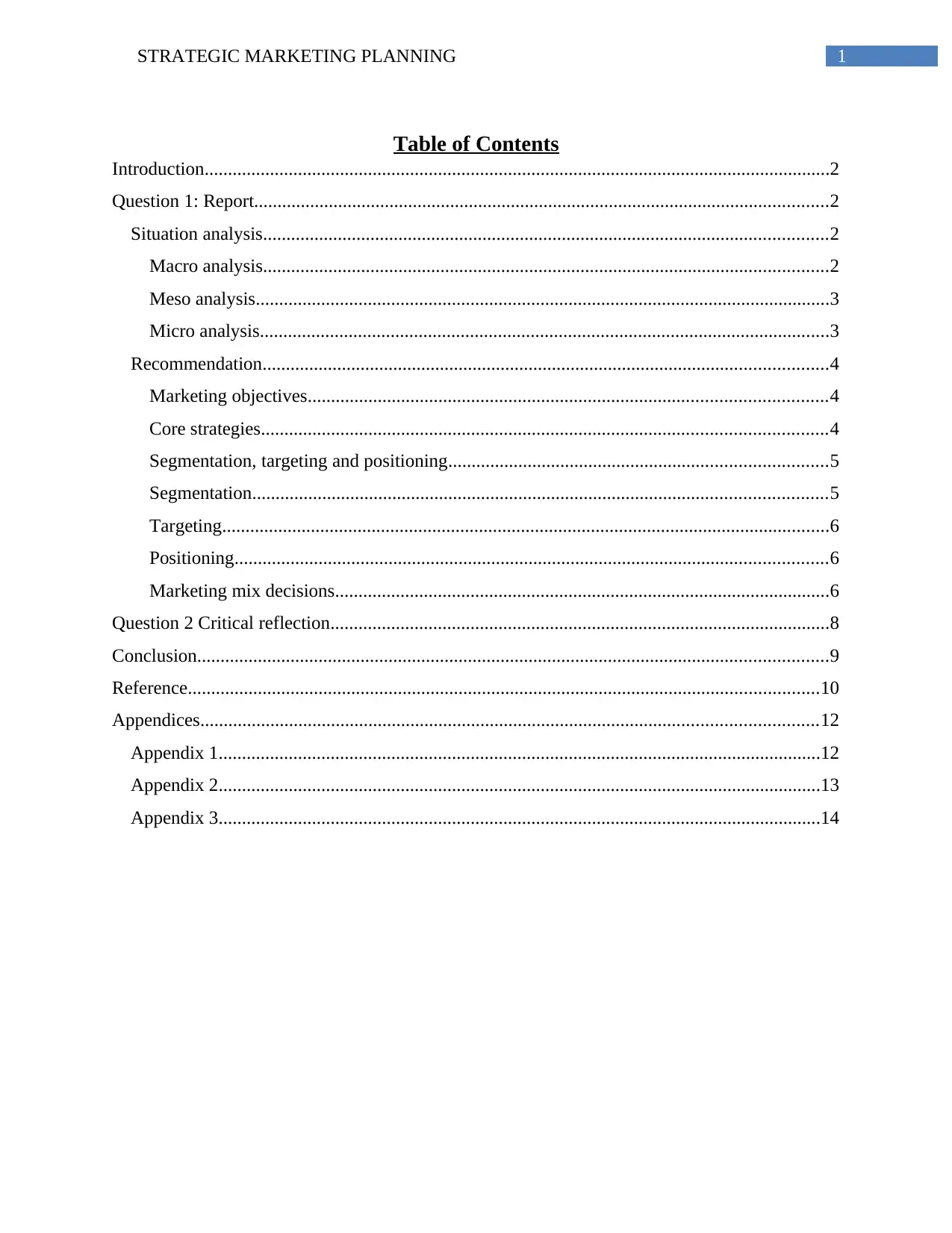
1STRATEGIC MARKETING PLANNING
Table of Contents
Introduction......................................................................................................................................2
Question 1: Report...........................................................................................................................2
Situation analysis.........................................................................................................................2
Macro analysis.........................................................................................................................2
Meso analysis...........................................................................................................................3
Micro analysis..........................................................................................................................3
Recommendation.........................................................................................................................4
Marketing objectives...............................................................................................................4
Core strategies.........................................................................................................................4
Segmentation, targeting and positioning.................................................................................5
Segmentation...........................................................................................................................5
Targeting..................................................................................................................................6
Positioning...............................................................................................................................6
Marketing mix decisions..........................................................................................................6
Question 2 Critical reflection...........................................................................................................8
Conclusion.......................................................................................................................................9
Reference.......................................................................................................................................10
Appendices....................................................................................................................................12
Appendix 1.................................................................................................................................12
Appendix 2.................................................................................................................................13
Appendix 3.................................................................................................................................14
Table of Contents
Introduction......................................................................................................................................2
Question 1: Report...........................................................................................................................2
Situation analysis.........................................................................................................................2
Macro analysis.........................................................................................................................2
Meso analysis...........................................................................................................................3
Micro analysis..........................................................................................................................3
Recommendation.........................................................................................................................4
Marketing objectives...............................................................................................................4
Core strategies.........................................................................................................................4
Segmentation, targeting and positioning.................................................................................5
Segmentation...........................................................................................................................5
Targeting..................................................................................................................................6
Positioning...............................................................................................................................6
Marketing mix decisions..........................................................................................................6
Question 2 Critical reflection...........................................................................................................8
Conclusion.......................................................................................................................................9
Reference.......................................................................................................................................10
Appendices....................................................................................................................................12
Appendix 1.................................................................................................................................12
Appendix 2.................................................................................................................................13
Appendix 3.................................................................................................................................14
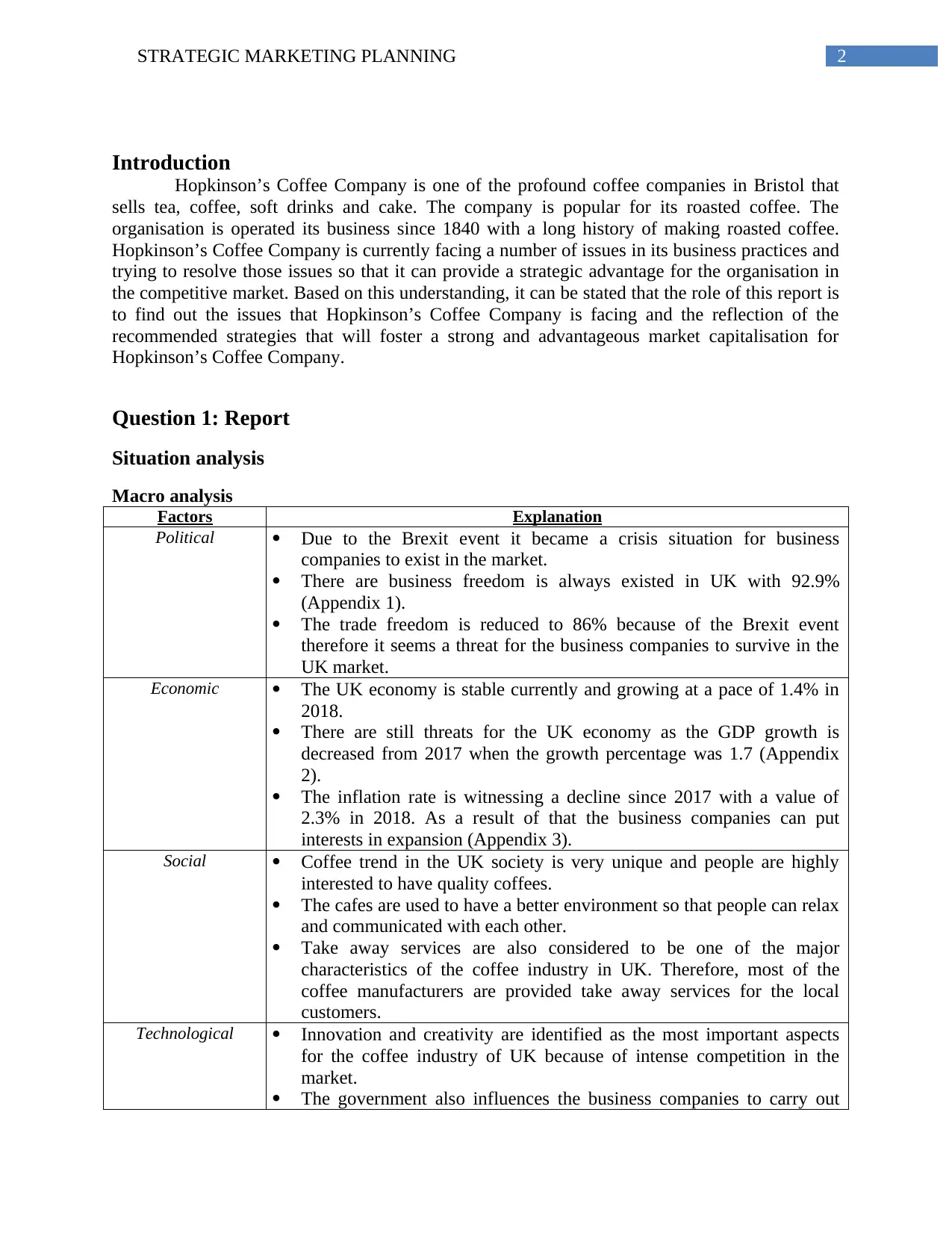
2STRATEGIC MARKETING PLANNING
Introduction
Hopkinson’s Coffee Company is one of the profound coffee companies in Bristol that
sells tea, coffee, soft drinks and cake. The company is popular for its roasted coffee. The
organisation is operated its business since 1840 with a long history of making roasted coffee.
Hopkinson’s Coffee Company is currently facing a number of issues in its business practices and
trying to resolve those issues so that it can provide a strategic advantage for the organisation in
the competitive market. Based on this understanding, it can be stated that the role of this report is
to find out the issues that Hopkinson’s Coffee Company is facing and the reflection of the
recommended strategies that will foster a strong and advantageous market capitalisation for
Hopkinson’s Coffee Company.
Question 1: Report
Situation analysis
Macro analysis
Factors Explanation
Political Due to the Brexit event it became a crisis situation for business
companies to exist in the market.
There are business freedom is always existed in UK with 92.9%
(Appendix 1).
The trade freedom is reduced to 86% because of the Brexit event
therefore it seems a threat for the business companies to survive in the
UK market.
Economic The UK economy is stable currently and growing at a pace of 1.4% in
2018.
There are still threats for the UK economy as the GDP growth is
decreased from 2017 when the growth percentage was 1.7 (Appendix
2).
The inflation rate is witnessing a decline since 2017 with a value of
2.3% in 2018. As a result of that the business companies can put
interests in expansion (Appendix 3).
Social Coffee trend in the UK society is very unique and people are highly
interested to have quality coffees.
The cafes are used to have a better environment so that people can relax
and communicated with each other.
Take away services are also considered to be one of the major
characteristics of the coffee industry in UK. Therefore, most of the
coffee manufacturers are provided take away services for the local
customers.
Technological Innovation and creativity are identified as the most important aspects
for the coffee industry of UK because of intense competition in the
market.
The government also influences the business companies to carry out
Introduction
Hopkinson’s Coffee Company is one of the profound coffee companies in Bristol that
sells tea, coffee, soft drinks and cake. The company is popular for its roasted coffee. The
organisation is operated its business since 1840 with a long history of making roasted coffee.
Hopkinson’s Coffee Company is currently facing a number of issues in its business practices and
trying to resolve those issues so that it can provide a strategic advantage for the organisation in
the competitive market. Based on this understanding, it can be stated that the role of this report is
to find out the issues that Hopkinson’s Coffee Company is facing and the reflection of the
recommended strategies that will foster a strong and advantageous market capitalisation for
Hopkinson’s Coffee Company.
Question 1: Report
Situation analysis
Macro analysis
Factors Explanation
Political Due to the Brexit event it became a crisis situation for business
companies to exist in the market.
There are business freedom is always existed in UK with 92.9%
(Appendix 1).
The trade freedom is reduced to 86% because of the Brexit event
therefore it seems a threat for the business companies to survive in the
UK market.
Economic The UK economy is stable currently and growing at a pace of 1.4% in
2018.
There are still threats for the UK economy as the GDP growth is
decreased from 2017 when the growth percentage was 1.7 (Appendix
2).
The inflation rate is witnessing a decline since 2017 with a value of
2.3% in 2018. As a result of that the business companies can put
interests in expansion (Appendix 3).
Social Coffee trend in the UK society is very unique and people are highly
interested to have quality coffees.
The cafes are used to have a better environment so that people can relax
and communicated with each other.
Take away services are also considered to be one of the major
characteristics of the coffee industry in UK. Therefore, most of the
coffee manufacturers are provided take away services for the local
customers.
Technological Innovation and creativity are identified as the most important aspects
for the coffee industry of UK because of intense competition in the
market.
The government also influences the business companies to carry out
⊘ This is a preview!⊘
Do you want full access?
Subscribe today to unlock all pages.

Trusted by 1+ million students worldwide
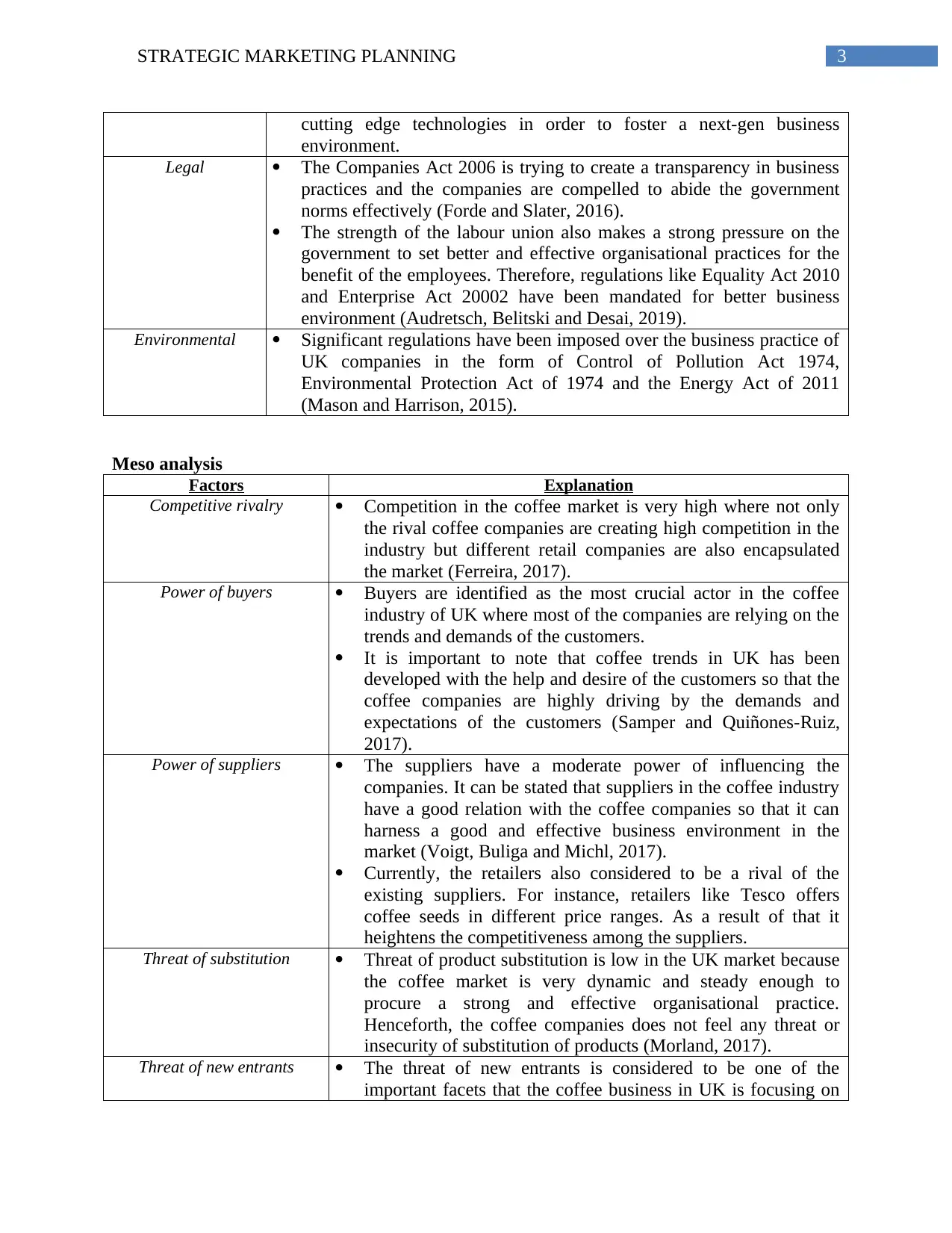
3STRATEGIC MARKETING PLANNING
cutting edge technologies in order to foster a next-gen business
environment.
Legal The Companies Act 2006 is trying to create a transparency in business
practices and the companies are compelled to abide the government
norms effectively (Forde and Slater, 2016).
The strength of the labour union also makes a strong pressure on the
government to set better and effective organisational practices for the
benefit of the employees. Therefore, regulations like Equality Act 2010
and Enterprise Act 20002 have been mandated for better business
environment (Audretsch, Belitski and Desai, 2019).
Environmental Significant regulations have been imposed over the business practice of
UK companies in the form of Control of Pollution Act 1974,
Environmental Protection Act of 1974 and the Energy Act of 2011
(Mason and Harrison, 2015).
Meso analysis
Factors Explanation
Competitive rivalry Competition in the coffee market is very high where not only
the rival coffee companies are creating high competition in the
industry but different retail companies are also encapsulated
the market (Ferreira, 2017).
Power of buyers Buyers are identified as the most crucial actor in the coffee
industry of UK where most of the companies are relying on the
trends and demands of the customers.
It is important to note that coffee trends in UK has been
developed with the help and desire of the customers so that the
coffee companies are highly driving by the demands and
expectations of the customers (Samper and Quiñones-Ruiz,
2017).
Power of suppliers The suppliers have a moderate power of influencing the
companies. It can be stated that suppliers in the coffee industry
have a good relation with the coffee companies so that it can
harness a good and effective business environment in the
market (Voigt, Buliga and Michl, 2017).
Currently, the retailers also considered to be a rival of the
existing suppliers. For instance, retailers like Tesco offers
coffee seeds in different price ranges. As a result of that it
heightens the competitiveness among the suppliers.
Threat of substitution Threat of product substitution is low in the UK market because
the coffee market is very dynamic and steady enough to
procure a strong and effective organisational practice.
Henceforth, the coffee companies does not feel any threat or
insecurity of substitution of products (Morland, 2017).
Threat of new entrants The threat of new entrants is considered to be one of the
important facets that the coffee business in UK is focusing on
cutting edge technologies in order to foster a next-gen business
environment.
Legal The Companies Act 2006 is trying to create a transparency in business
practices and the companies are compelled to abide the government
norms effectively (Forde and Slater, 2016).
The strength of the labour union also makes a strong pressure on the
government to set better and effective organisational practices for the
benefit of the employees. Therefore, regulations like Equality Act 2010
and Enterprise Act 20002 have been mandated for better business
environment (Audretsch, Belitski and Desai, 2019).
Environmental Significant regulations have been imposed over the business practice of
UK companies in the form of Control of Pollution Act 1974,
Environmental Protection Act of 1974 and the Energy Act of 2011
(Mason and Harrison, 2015).
Meso analysis
Factors Explanation
Competitive rivalry Competition in the coffee market is very high where not only
the rival coffee companies are creating high competition in the
industry but different retail companies are also encapsulated
the market (Ferreira, 2017).
Power of buyers Buyers are identified as the most crucial actor in the coffee
industry of UK where most of the companies are relying on the
trends and demands of the customers.
It is important to note that coffee trends in UK has been
developed with the help and desire of the customers so that the
coffee companies are highly driving by the demands and
expectations of the customers (Samper and Quiñones-Ruiz,
2017).
Power of suppliers The suppliers have a moderate power of influencing the
companies. It can be stated that suppliers in the coffee industry
have a good relation with the coffee companies so that it can
harness a good and effective business environment in the
market (Voigt, Buliga and Michl, 2017).
Currently, the retailers also considered to be a rival of the
existing suppliers. For instance, retailers like Tesco offers
coffee seeds in different price ranges. As a result of that it
heightens the competitiveness among the suppliers.
Threat of substitution Threat of product substitution is low in the UK market because
the coffee market is very dynamic and steady enough to
procure a strong and effective organisational practice.
Henceforth, the coffee companies does not feel any threat or
insecurity of substitution of products (Morland, 2017).
Threat of new entrants The threat of new entrants is considered to be one of the
important facets that the coffee business in UK is focusing on
Paraphrase This Document
Need a fresh take? Get an instant paraphrase of this document with our AI Paraphraser
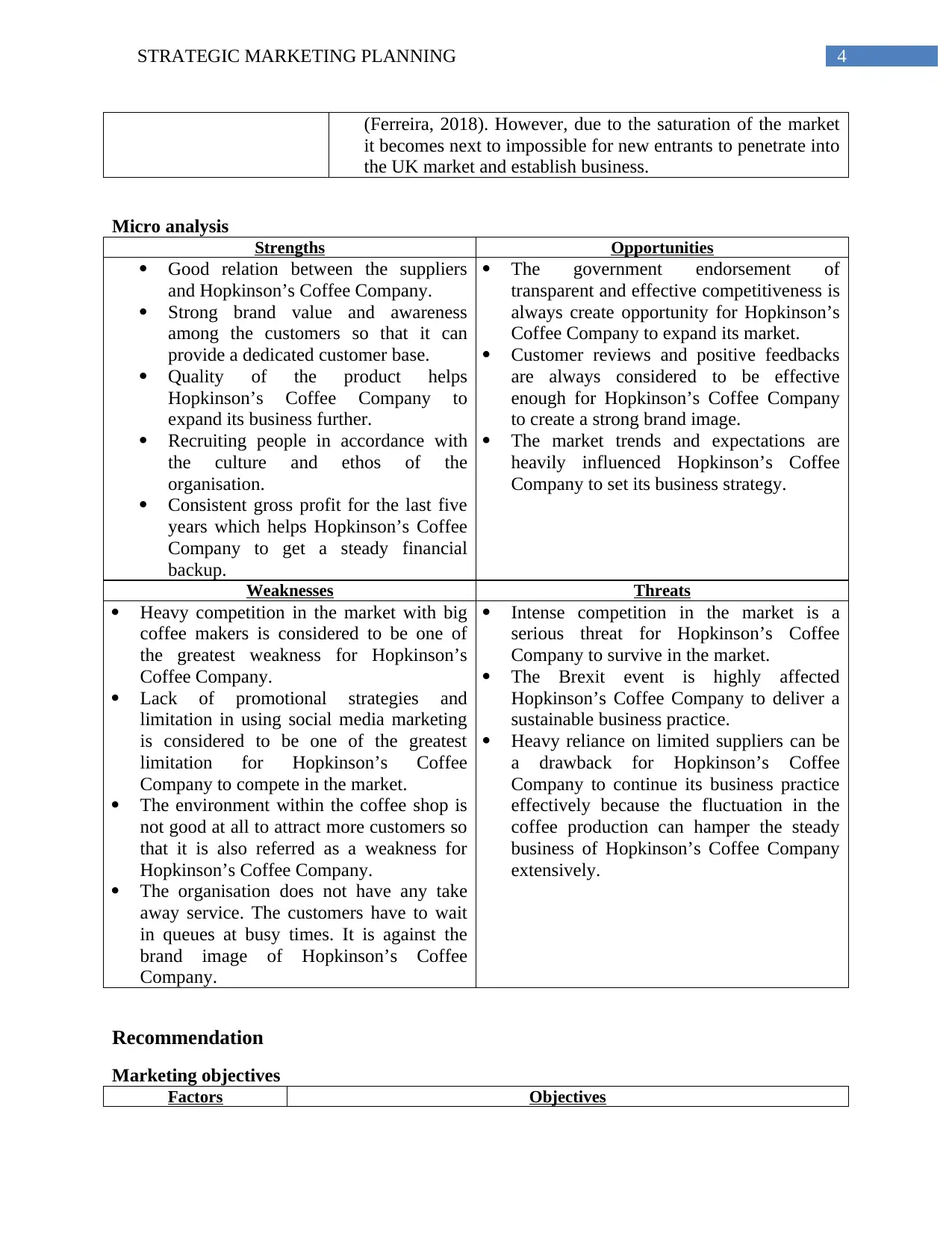
4STRATEGIC MARKETING PLANNING
(Ferreira, 2018). However, due to the saturation of the market
it becomes next to impossible for new entrants to penetrate into
the UK market and establish business.
Micro analysis
Strengths Opportunities
Good relation between the suppliers
and Hopkinson’s Coffee Company.
Strong brand value and awareness
among the customers so that it can
provide a dedicated customer base.
Quality of the product helps
Hopkinson’s Coffee Company to
expand its business further.
Recruiting people in accordance with
the culture and ethos of the
organisation.
Consistent gross profit for the last five
years which helps Hopkinson’s Coffee
Company to get a steady financial
backup.
The government endorsement of
transparent and effective competitiveness is
always create opportunity for Hopkinson’s
Coffee Company to expand its market.
Customer reviews and positive feedbacks
are always considered to be effective
enough for Hopkinson’s Coffee Company
to create a strong brand image.
The market trends and expectations are
heavily influenced Hopkinson’s Coffee
Company to set its business strategy.
Weaknesses Threats
Heavy competition in the market with big
coffee makers is considered to be one of
the greatest weakness for Hopkinson’s
Coffee Company.
Lack of promotional strategies and
limitation in using social media marketing
is considered to be one of the greatest
limitation for Hopkinson’s Coffee
Company to compete in the market.
The environment within the coffee shop is
not good at all to attract more customers so
that it is also referred as a weakness for
Hopkinson’s Coffee Company.
The organisation does not have any take
away service. The customers have to wait
in queues at busy times. It is against the
brand image of Hopkinson’s Coffee
Company.
Intense competition in the market is a
serious threat for Hopkinson’s Coffee
Company to survive in the market.
The Brexit event is highly affected
Hopkinson’s Coffee Company to deliver a
sustainable business practice.
Heavy reliance on limited suppliers can be
a drawback for Hopkinson’s Coffee
Company to continue its business practice
effectively because the fluctuation in the
coffee production can hamper the steady
business of Hopkinson’s Coffee Company
extensively.
Recommendation
Marketing objectives
Factors Objectives
(Ferreira, 2018). However, due to the saturation of the market
it becomes next to impossible for new entrants to penetrate into
the UK market and establish business.
Micro analysis
Strengths Opportunities
Good relation between the suppliers
and Hopkinson’s Coffee Company.
Strong brand value and awareness
among the customers so that it can
provide a dedicated customer base.
Quality of the product helps
Hopkinson’s Coffee Company to
expand its business further.
Recruiting people in accordance with
the culture and ethos of the
organisation.
Consistent gross profit for the last five
years which helps Hopkinson’s Coffee
Company to get a steady financial
backup.
The government endorsement of
transparent and effective competitiveness is
always create opportunity for Hopkinson’s
Coffee Company to expand its market.
Customer reviews and positive feedbacks
are always considered to be effective
enough for Hopkinson’s Coffee Company
to create a strong brand image.
The market trends and expectations are
heavily influenced Hopkinson’s Coffee
Company to set its business strategy.
Weaknesses Threats
Heavy competition in the market with big
coffee makers is considered to be one of
the greatest weakness for Hopkinson’s
Coffee Company.
Lack of promotional strategies and
limitation in using social media marketing
is considered to be one of the greatest
limitation for Hopkinson’s Coffee
Company to compete in the market.
The environment within the coffee shop is
not good at all to attract more customers so
that it is also referred as a weakness for
Hopkinson’s Coffee Company.
The organisation does not have any take
away service. The customers have to wait
in queues at busy times. It is against the
brand image of Hopkinson’s Coffee
Company.
Intense competition in the market is a
serious threat for Hopkinson’s Coffee
Company to survive in the market.
The Brexit event is highly affected
Hopkinson’s Coffee Company to deliver a
sustainable business practice.
Heavy reliance on limited suppliers can be
a drawback for Hopkinson’s Coffee
Company to continue its business practice
effectively because the fluctuation in the
coffee production can hamper the steady
business of Hopkinson’s Coffee Company
extensively.
Recommendation
Marketing objectives
Factors Objectives
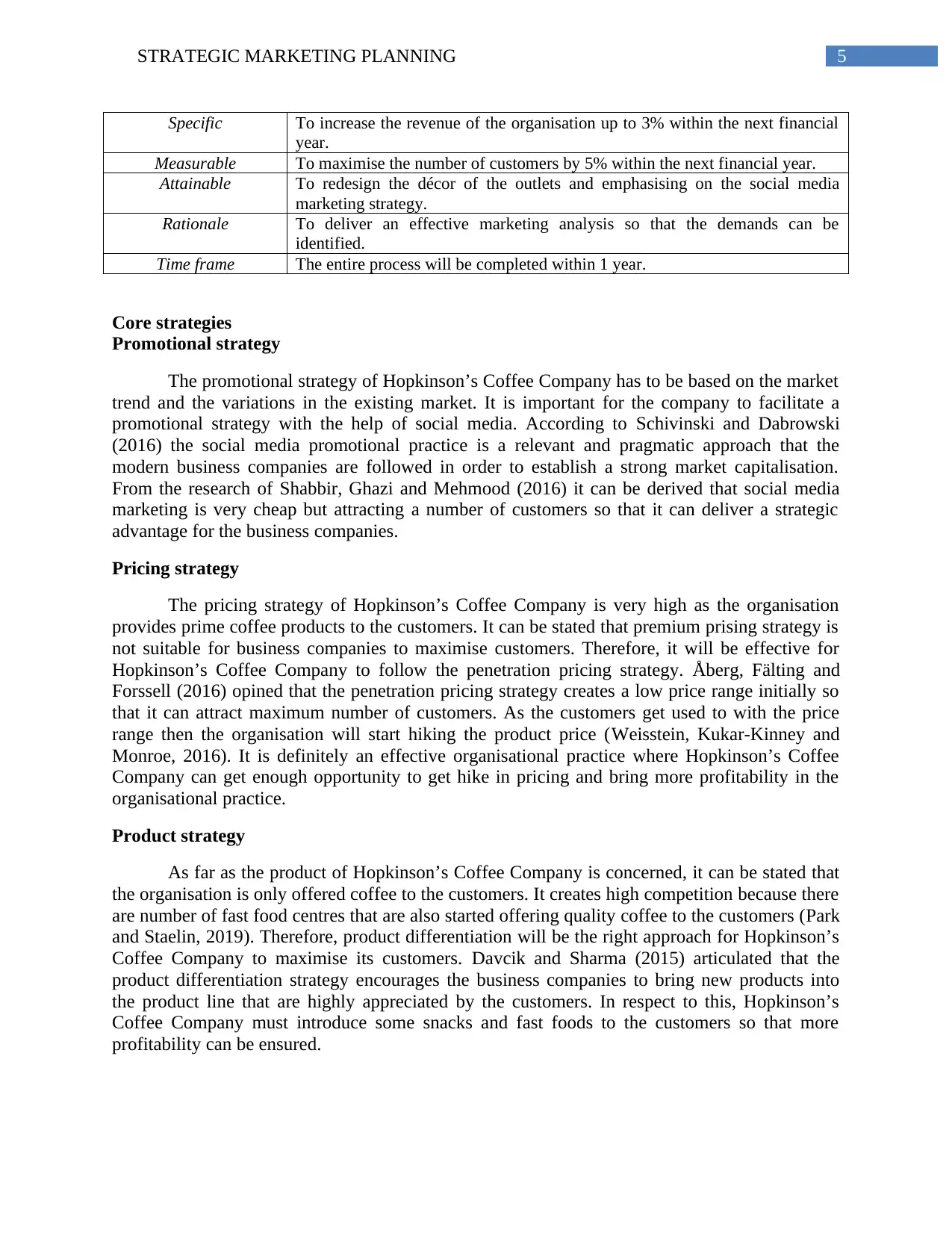
5STRATEGIC MARKETING PLANNING
Specific To increase the revenue of the organisation up to 3% within the next financial
year.
Measurable To maximise the number of customers by 5% within the next financial year.
Attainable To redesign the décor of the outlets and emphasising on the social media
marketing strategy.
Rationale To deliver an effective marketing analysis so that the demands can be
identified.
Time frame The entire process will be completed within 1 year.
Core strategies
Promotional strategy
The promotional strategy of Hopkinson’s Coffee Company has to be based on the market
trend and the variations in the existing market. It is important for the company to facilitate a
promotional strategy with the help of social media. According to Schivinski and Dabrowski
(2016) the social media promotional practice is a relevant and pragmatic approach that the
modern business companies are followed in order to establish a strong market capitalisation.
From the research of Shabbir, Ghazi and Mehmood (2016) it can be derived that social media
marketing is very cheap but attracting a number of customers so that it can deliver a strategic
advantage for the business companies.
Pricing strategy
The pricing strategy of Hopkinson’s Coffee Company is very high as the organisation
provides prime coffee products to the customers. It can be stated that premium prising strategy is
not suitable for business companies to maximise customers. Therefore, it will be effective for
Hopkinson’s Coffee Company to follow the penetration pricing strategy. Åberg, Fälting and
Forssell (2016) opined that the penetration pricing strategy creates a low price range initially so
that it can attract maximum number of customers. As the customers get used to with the price
range then the organisation will start hiking the product price (Weisstein, Kukar-Kinney and
Monroe, 2016). It is definitely an effective organisational practice where Hopkinson’s Coffee
Company can get enough opportunity to get hike in pricing and bring more profitability in the
organisational practice.
Product strategy
As far as the product of Hopkinson’s Coffee Company is concerned, it can be stated that
the organisation is only offered coffee to the customers. It creates high competition because there
are number of fast food centres that are also started offering quality coffee to the customers (Park
and Staelin, 2019). Therefore, product differentiation will be the right approach for Hopkinson’s
Coffee Company to maximise its customers. Davcik and Sharma (2015) articulated that the
product differentiation strategy encourages the business companies to bring new products into
the product line that are highly appreciated by the customers. In respect to this, Hopkinson’s
Coffee Company must introduce some snacks and fast foods to the customers so that more
profitability can be ensured.
Specific To increase the revenue of the organisation up to 3% within the next financial
year.
Measurable To maximise the number of customers by 5% within the next financial year.
Attainable To redesign the décor of the outlets and emphasising on the social media
marketing strategy.
Rationale To deliver an effective marketing analysis so that the demands can be
identified.
Time frame The entire process will be completed within 1 year.
Core strategies
Promotional strategy
The promotional strategy of Hopkinson’s Coffee Company has to be based on the market
trend and the variations in the existing market. It is important for the company to facilitate a
promotional strategy with the help of social media. According to Schivinski and Dabrowski
(2016) the social media promotional practice is a relevant and pragmatic approach that the
modern business companies are followed in order to establish a strong market capitalisation.
From the research of Shabbir, Ghazi and Mehmood (2016) it can be derived that social media
marketing is very cheap but attracting a number of customers so that it can deliver a strategic
advantage for the business companies.
Pricing strategy
The pricing strategy of Hopkinson’s Coffee Company is very high as the organisation
provides prime coffee products to the customers. It can be stated that premium prising strategy is
not suitable for business companies to maximise customers. Therefore, it will be effective for
Hopkinson’s Coffee Company to follow the penetration pricing strategy. Åberg, Fälting and
Forssell (2016) opined that the penetration pricing strategy creates a low price range initially so
that it can attract maximum number of customers. As the customers get used to with the price
range then the organisation will start hiking the product price (Weisstein, Kukar-Kinney and
Monroe, 2016). It is definitely an effective organisational practice where Hopkinson’s Coffee
Company can get enough opportunity to get hike in pricing and bring more profitability in the
organisational practice.
Product strategy
As far as the product of Hopkinson’s Coffee Company is concerned, it can be stated that
the organisation is only offered coffee to the customers. It creates high competition because there
are number of fast food centres that are also started offering quality coffee to the customers (Park
and Staelin, 2019). Therefore, product differentiation will be the right approach for Hopkinson’s
Coffee Company to maximise its customers. Davcik and Sharma (2015) articulated that the
product differentiation strategy encourages the business companies to bring new products into
the product line that are highly appreciated by the customers. In respect to this, Hopkinson’s
Coffee Company must introduce some snacks and fast foods to the customers so that more
profitability can be ensured.
⊘ This is a preview!⊘
Do you want full access?
Subscribe today to unlock all pages.

Trusted by 1+ million students worldwide
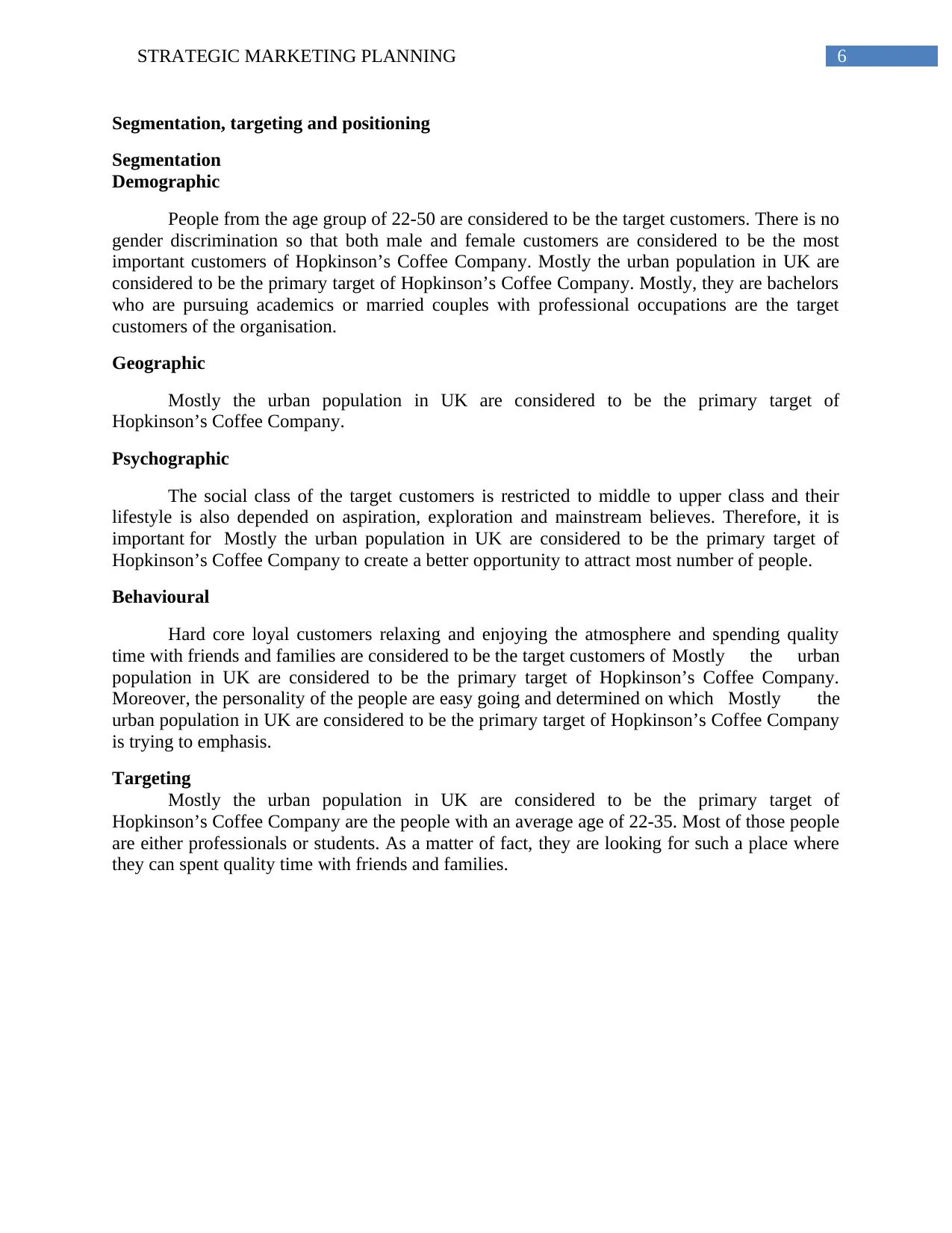
6STRATEGIC MARKETING PLANNING
Segmentation, targeting and positioning
Segmentation
Demographic
People from the age group of 22-50 are considered to be the target customers. There is no
gender discrimination so that both male and female customers are considered to be the most
important customers of Hopkinson’s Coffee Company. Mostly the urban population in UK are
considered to be the primary target of Hopkinson’s Coffee Company. Mostly, they are bachelors
who are pursuing academics or married couples with professional occupations are the target
customers of the organisation.
Geographic
Mostly the urban population in UK are considered to be the primary target of
Hopkinson’s Coffee Company.
Psychographic
The social class of the target customers is restricted to middle to upper class and their
lifestyle is also depended on aspiration, exploration and mainstream believes. Therefore, it is
important for Mostly the urban population in UK are considered to be the primary target of
Hopkinson’s Coffee Company to create a better opportunity to attract most number of people.
Behavioural
Hard core loyal customers relaxing and enjoying the atmosphere and spending quality
time with friends and families are considered to be the target customers of Mostly the urban
population in UK are considered to be the primary target of Hopkinson’s Coffee Company.
Moreover, the personality of the people are easy going and determined on which Mostly the
urban population in UK are considered to be the primary target of Hopkinson’s Coffee Company
is trying to emphasis.
Targeting
Mostly the urban population in UK are considered to be the primary target of
Hopkinson’s Coffee Company are the people with an average age of 22-35. Most of those people
are either professionals or students. As a matter of fact, they are looking for such a place where
they can spent quality time with friends and families.
Segmentation, targeting and positioning
Segmentation
Demographic
People from the age group of 22-50 are considered to be the target customers. There is no
gender discrimination so that both male and female customers are considered to be the most
important customers of Hopkinson’s Coffee Company. Mostly the urban population in UK are
considered to be the primary target of Hopkinson’s Coffee Company. Mostly, they are bachelors
who are pursuing academics or married couples with professional occupations are the target
customers of the organisation.
Geographic
Mostly the urban population in UK are considered to be the primary target of
Hopkinson’s Coffee Company.
Psychographic
The social class of the target customers is restricted to middle to upper class and their
lifestyle is also depended on aspiration, exploration and mainstream believes. Therefore, it is
important for Mostly the urban population in UK are considered to be the primary target of
Hopkinson’s Coffee Company to create a better opportunity to attract most number of people.
Behavioural
Hard core loyal customers relaxing and enjoying the atmosphere and spending quality
time with friends and families are considered to be the target customers of Mostly the urban
population in UK are considered to be the primary target of Hopkinson’s Coffee Company.
Moreover, the personality of the people are easy going and determined on which Mostly the
urban population in UK are considered to be the primary target of Hopkinson’s Coffee Company
is trying to emphasis.
Targeting
Mostly the urban population in UK are considered to be the primary target of
Hopkinson’s Coffee Company are the people with an average age of 22-35. Most of those people
are either professionals or students. As a matter of fact, they are looking for such a place where
they can spent quality time with friends and families.
Paraphrase This Document
Need a fresh take? Get an instant paraphrase of this document with our AI Paraphraser
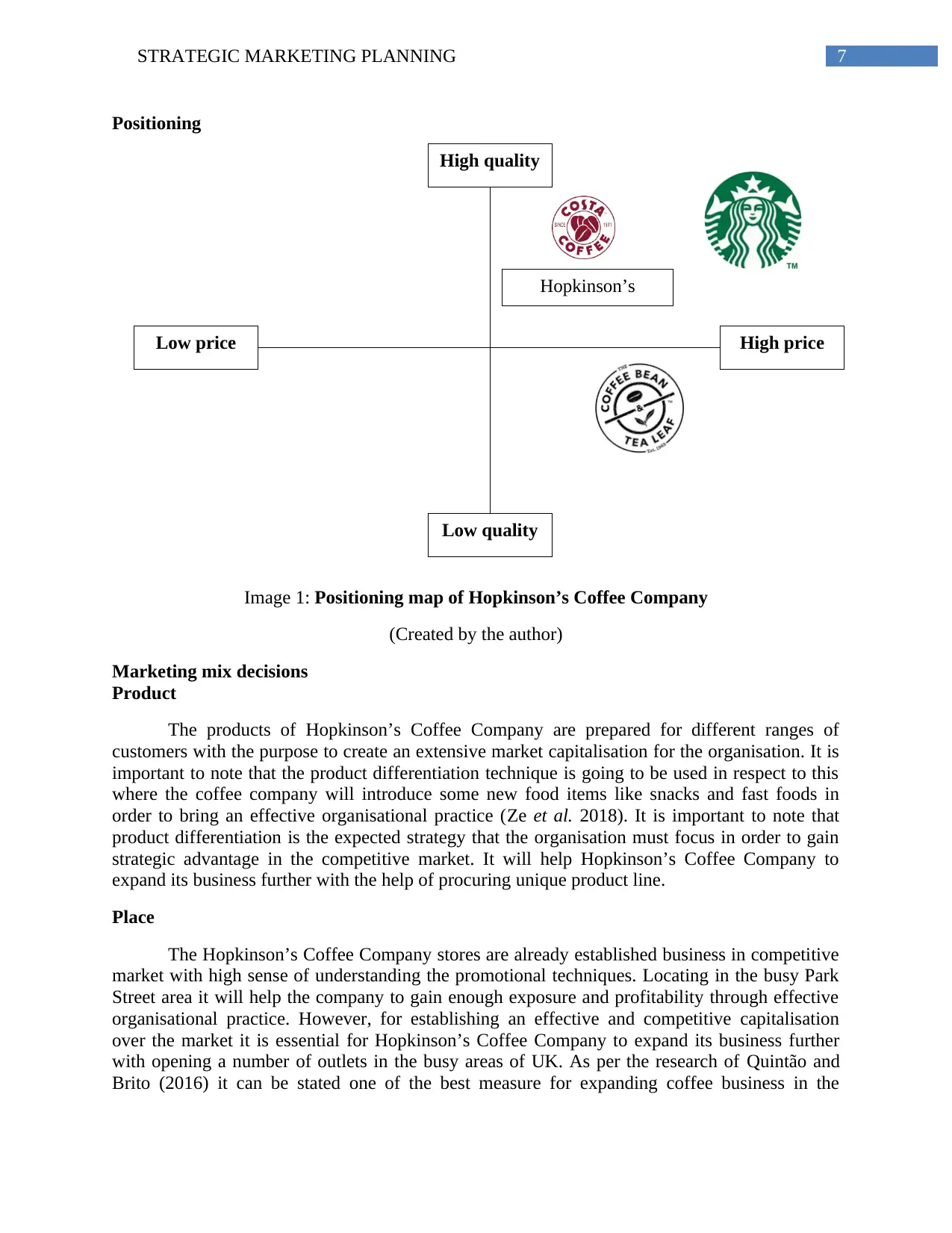
7STRATEGIC MARKETING PLANNING
High quality
Low price High price
Low quality
Hopkinson’s
Positioning
Image 1: Positioning map of Hopkinson’s Coffee Company
(Created by the author)
Marketing mix decisions
Product
The products of Hopkinson’s Coffee Company are prepared for different ranges of
customers with the purpose to create an extensive market capitalisation for the organisation. It is
important to note that the product differentiation technique is going to be used in respect to this
where the coffee company will introduce some new food items like snacks and fast foods in
order to bring an effective organisational practice (Ze et al. 2018). It is important to note that
product differentiation is the expected strategy that the organisation must focus in order to gain
strategic advantage in the competitive market. It will help Hopkinson’s Coffee Company to
expand its business further with the help of procuring unique product line.
Place
The Hopkinson’s Coffee Company stores are already established business in competitive
market with high sense of understanding the promotional techniques. Locating in the busy Park
Street area it will help the company to gain enough exposure and profitability through effective
organisational practice. However, for establishing an effective and competitive capitalisation
over the market it is essential for Hopkinson’s Coffee Company to expand its business further
with opening a number of outlets in the busy areas of UK. As per the research of Quintão and
Brito (2016) it can be stated one of the best measure for expanding coffee business in the
High quality
Low price High price
Low quality
Hopkinson’s
Positioning
Image 1: Positioning map of Hopkinson’s Coffee Company
(Created by the author)
Marketing mix decisions
Product
The products of Hopkinson’s Coffee Company are prepared for different ranges of
customers with the purpose to create an extensive market capitalisation for the organisation. It is
important to note that the product differentiation technique is going to be used in respect to this
where the coffee company will introduce some new food items like snacks and fast foods in
order to bring an effective organisational practice (Ze et al. 2018). It is important to note that
product differentiation is the expected strategy that the organisation must focus in order to gain
strategic advantage in the competitive market. It will help Hopkinson’s Coffee Company to
expand its business further with the help of procuring unique product line.
Place
The Hopkinson’s Coffee Company stores are already established business in competitive
market with high sense of understanding the promotional techniques. Locating in the busy Park
Street area it will help the company to gain enough exposure and profitability through effective
organisational practice. However, for establishing an effective and competitive capitalisation
over the market it is essential for Hopkinson’s Coffee Company to expand its business further
with opening a number of outlets in the busy areas of UK. As per the research of Quintão and
Brito (2016) it can be stated one of the best measure for expanding coffee business in the
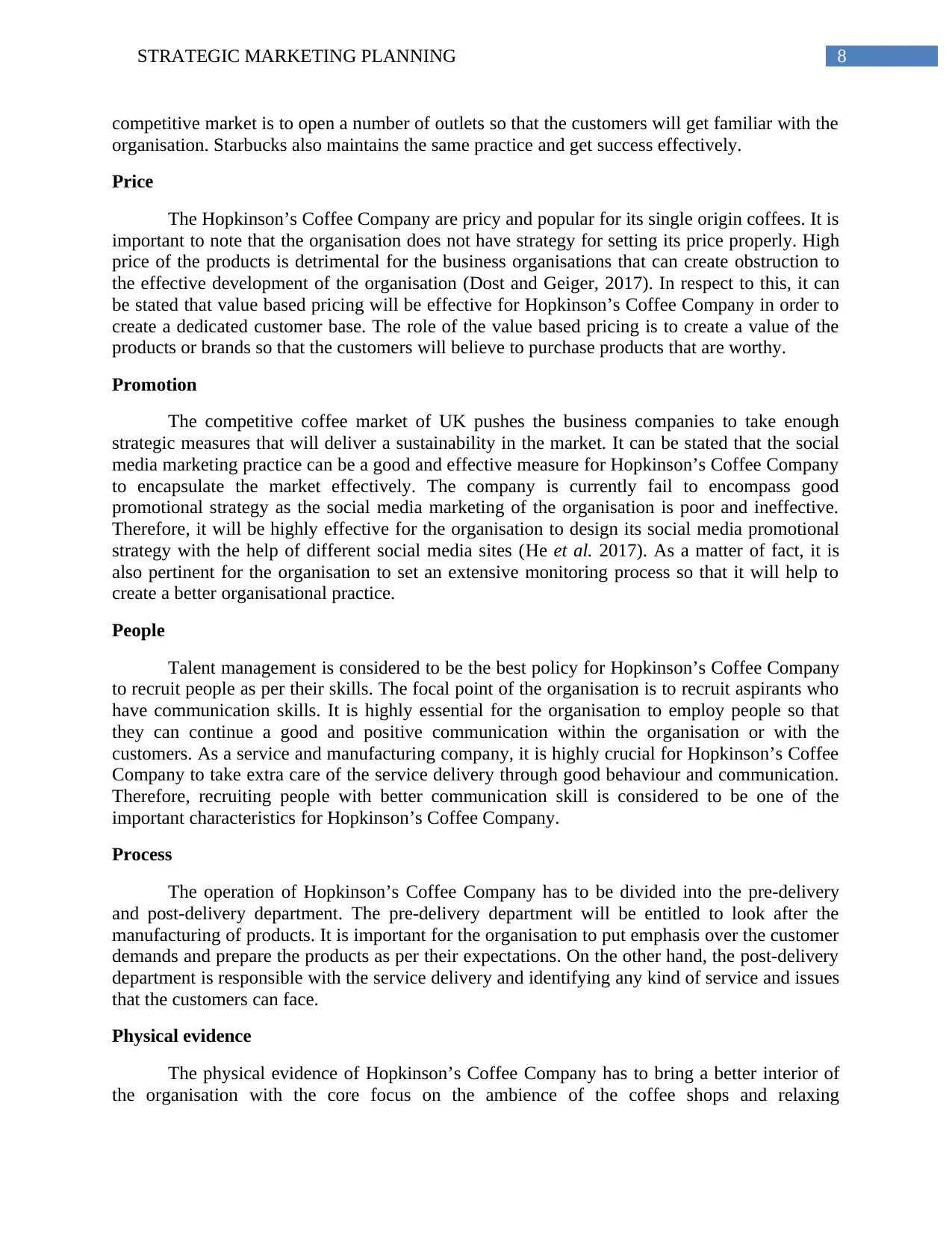
8STRATEGIC MARKETING PLANNING
competitive market is to open a number of outlets so that the customers will get familiar with the
organisation. Starbucks also maintains the same practice and get success effectively.
Price
The Hopkinson’s Coffee Company are pricy and popular for its single origin coffees. It is
important to note that the organisation does not have strategy for setting its price properly. High
price of the products is detrimental for the business organisations that can create obstruction to
the effective development of the organisation (Dost and Geiger, 2017). In respect to this, it can
be stated that value based pricing will be effective for Hopkinson’s Coffee Company in order to
create a dedicated customer base. The role of the value based pricing is to create a value of the
products or brands so that the customers will believe to purchase products that are worthy.
Promotion
The competitive coffee market of UK pushes the business companies to take enough
strategic measures that will deliver a sustainability in the market. It can be stated that the social
media marketing practice can be a good and effective measure for Hopkinson’s Coffee Company
to encapsulate the market effectively. The company is currently fail to encompass good
promotional strategy as the social media marketing of the organisation is poor and ineffective.
Therefore, it will be highly effective for the organisation to design its social media promotional
strategy with the help of different social media sites (He et al. 2017). As a matter of fact, it is
also pertinent for the organisation to set an extensive monitoring process so that it will help to
create a better organisational practice.
People
Talent management is considered to be the best policy for Hopkinson’s Coffee Company
to recruit people as per their skills. The focal point of the organisation is to recruit aspirants who
have communication skills. It is highly essential for the organisation to employ people so that
they can continue a good and positive communication within the organisation or with the
customers. As a service and manufacturing company, it is highly crucial for Hopkinson’s Coffee
Company to take extra care of the service delivery through good behaviour and communication.
Therefore, recruiting people with better communication skill is considered to be one of the
important characteristics for Hopkinson’s Coffee Company.
Process
The operation of Hopkinson’s Coffee Company has to be divided into the pre-delivery
and post-delivery department. The pre-delivery department will be entitled to look after the
manufacturing of products. It is important for the organisation to put emphasis over the customer
demands and prepare the products as per their expectations. On the other hand, the post-delivery
department is responsible with the service delivery and identifying any kind of service and issues
that the customers can face.
Physical evidence
The physical evidence of Hopkinson’s Coffee Company has to bring a better interior of
the organisation with the core focus on the ambience of the coffee shops and relaxing
competitive market is to open a number of outlets so that the customers will get familiar with the
organisation. Starbucks also maintains the same practice and get success effectively.
Price
The Hopkinson’s Coffee Company are pricy and popular for its single origin coffees. It is
important to note that the organisation does not have strategy for setting its price properly. High
price of the products is detrimental for the business organisations that can create obstruction to
the effective development of the organisation (Dost and Geiger, 2017). In respect to this, it can
be stated that value based pricing will be effective for Hopkinson’s Coffee Company in order to
create a dedicated customer base. The role of the value based pricing is to create a value of the
products or brands so that the customers will believe to purchase products that are worthy.
Promotion
The competitive coffee market of UK pushes the business companies to take enough
strategic measures that will deliver a sustainability in the market. It can be stated that the social
media marketing practice can be a good and effective measure for Hopkinson’s Coffee Company
to encapsulate the market effectively. The company is currently fail to encompass good
promotional strategy as the social media marketing of the organisation is poor and ineffective.
Therefore, it will be highly effective for the organisation to design its social media promotional
strategy with the help of different social media sites (He et al. 2017). As a matter of fact, it is
also pertinent for the organisation to set an extensive monitoring process so that it will help to
create a better organisational practice.
People
Talent management is considered to be the best policy for Hopkinson’s Coffee Company
to recruit people as per their skills. The focal point of the organisation is to recruit aspirants who
have communication skills. It is highly essential for the organisation to employ people so that
they can continue a good and positive communication within the organisation or with the
customers. As a service and manufacturing company, it is highly crucial for Hopkinson’s Coffee
Company to take extra care of the service delivery through good behaviour and communication.
Therefore, recruiting people with better communication skill is considered to be one of the
important characteristics for Hopkinson’s Coffee Company.
Process
The operation of Hopkinson’s Coffee Company has to be divided into the pre-delivery
and post-delivery department. The pre-delivery department will be entitled to look after the
manufacturing of products. It is important for the organisation to put emphasis over the customer
demands and prepare the products as per their expectations. On the other hand, the post-delivery
department is responsible with the service delivery and identifying any kind of service and issues
that the customers can face.
Physical evidence
The physical evidence of Hopkinson’s Coffee Company has to bring a better interior of
the organisation with the core focus on the ambience of the coffee shops and relaxing
⊘ This is a preview!⊘
Do you want full access?
Subscribe today to unlock all pages.

Trusted by 1+ million students worldwide
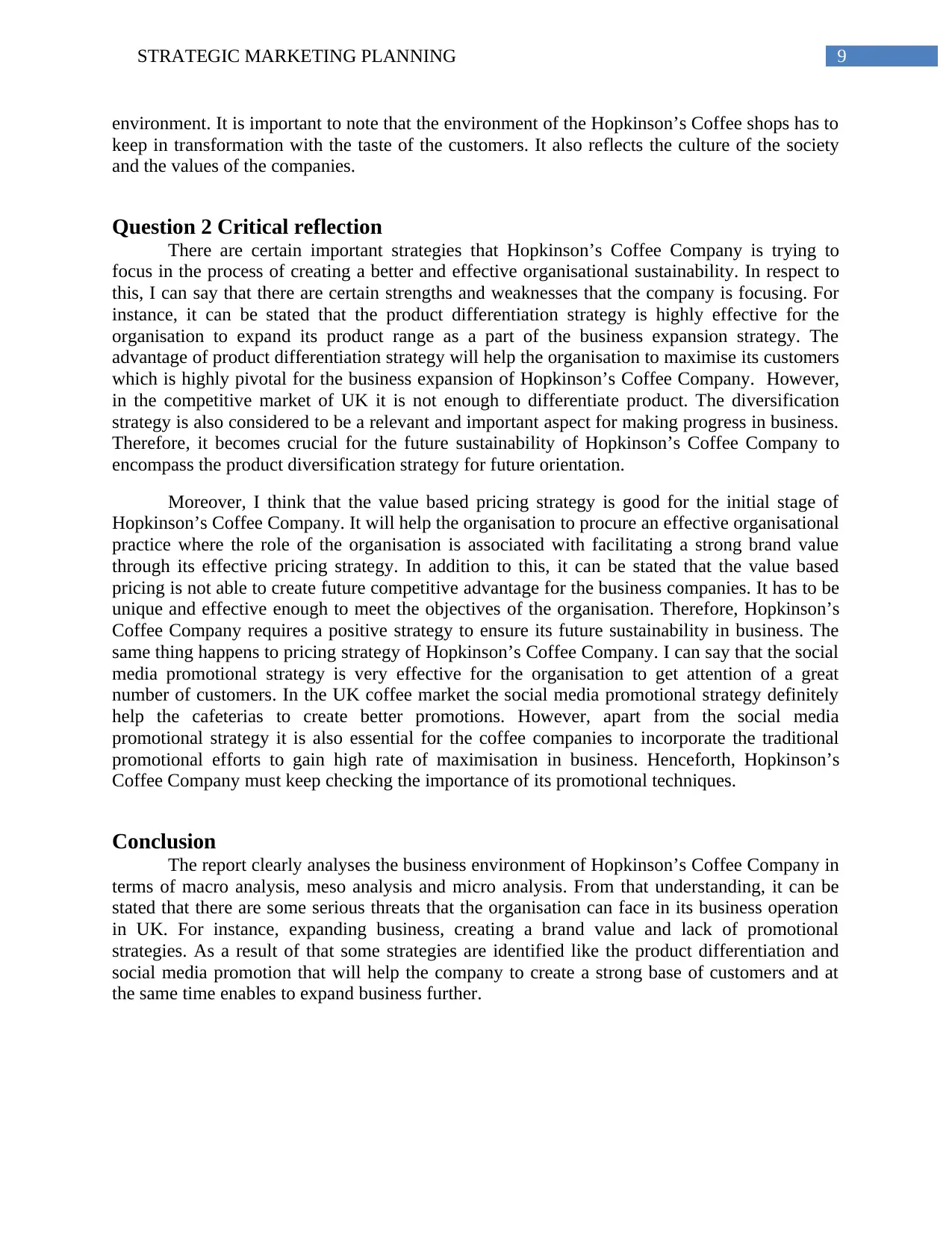
9STRATEGIC MARKETING PLANNING
environment. It is important to note that the environment of the Hopkinson’s Coffee shops has to
keep in transformation with the taste of the customers. It also reflects the culture of the society
and the values of the companies.
Question 2 Critical reflection
There are certain important strategies that Hopkinson’s Coffee Company is trying to
focus in the process of creating a better and effective organisational sustainability. In respect to
this, I can say that there are certain strengths and weaknesses that the company is focusing. For
instance, it can be stated that the product differentiation strategy is highly effective for the
organisation to expand its product range as a part of the business expansion strategy. The
advantage of product differentiation strategy will help the organisation to maximise its customers
which is highly pivotal for the business expansion of Hopkinson’s Coffee Company. However,
in the competitive market of UK it is not enough to differentiate product. The diversification
strategy is also considered to be a relevant and important aspect for making progress in business.
Therefore, it becomes crucial for the future sustainability of Hopkinson’s Coffee Company to
encompass the product diversification strategy for future orientation.
Moreover, I think that the value based pricing strategy is good for the initial stage of
Hopkinson’s Coffee Company. It will help the organisation to procure an effective organisational
practice where the role of the organisation is associated with facilitating a strong brand value
through its effective pricing strategy. In addition to this, it can be stated that the value based
pricing is not able to create future competitive advantage for the business companies. It has to be
unique and effective enough to meet the objectives of the organisation. Therefore, Hopkinson’s
Coffee Company requires a positive strategy to ensure its future sustainability in business. The
same thing happens to pricing strategy of Hopkinson’s Coffee Company. I can say that the social
media promotional strategy is very effective for the organisation to get attention of a great
number of customers. In the UK coffee market the social media promotional strategy definitely
help the cafeterias to create better promotions. However, apart from the social media
promotional strategy it is also essential for the coffee companies to incorporate the traditional
promotional efforts to gain high rate of maximisation in business. Henceforth, Hopkinson’s
Coffee Company must keep checking the importance of its promotional techniques.
Conclusion
The report clearly analyses the business environment of Hopkinson’s Coffee Company in
terms of macro analysis, meso analysis and micro analysis. From that understanding, it can be
stated that there are some serious threats that the organisation can face in its business operation
in UK. For instance, expanding business, creating a brand value and lack of promotional
strategies. As a result of that some strategies are identified like the product differentiation and
social media promotion that will help the company to create a strong base of customers and at
the same time enables to expand business further.
environment. It is important to note that the environment of the Hopkinson’s Coffee shops has to
keep in transformation with the taste of the customers. It also reflects the culture of the society
and the values of the companies.
Question 2 Critical reflection
There are certain important strategies that Hopkinson’s Coffee Company is trying to
focus in the process of creating a better and effective organisational sustainability. In respect to
this, I can say that there are certain strengths and weaknesses that the company is focusing. For
instance, it can be stated that the product differentiation strategy is highly effective for the
organisation to expand its product range as a part of the business expansion strategy. The
advantage of product differentiation strategy will help the organisation to maximise its customers
which is highly pivotal for the business expansion of Hopkinson’s Coffee Company. However,
in the competitive market of UK it is not enough to differentiate product. The diversification
strategy is also considered to be a relevant and important aspect for making progress in business.
Therefore, it becomes crucial for the future sustainability of Hopkinson’s Coffee Company to
encompass the product diversification strategy for future orientation.
Moreover, I think that the value based pricing strategy is good for the initial stage of
Hopkinson’s Coffee Company. It will help the organisation to procure an effective organisational
practice where the role of the organisation is associated with facilitating a strong brand value
through its effective pricing strategy. In addition to this, it can be stated that the value based
pricing is not able to create future competitive advantage for the business companies. It has to be
unique and effective enough to meet the objectives of the organisation. Therefore, Hopkinson’s
Coffee Company requires a positive strategy to ensure its future sustainability in business. The
same thing happens to pricing strategy of Hopkinson’s Coffee Company. I can say that the social
media promotional strategy is very effective for the organisation to get attention of a great
number of customers. In the UK coffee market the social media promotional strategy definitely
help the cafeterias to create better promotions. However, apart from the social media
promotional strategy it is also essential for the coffee companies to incorporate the traditional
promotional efforts to gain high rate of maximisation in business. Henceforth, Hopkinson’s
Coffee Company must keep checking the importance of its promotional techniques.
Conclusion
The report clearly analyses the business environment of Hopkinson’s Coffee Company in
terms of macro analysis, meso analysis and micro analysis. From that understanding, it can be
stated that there are some serious threats that the organisation can face in its business operation
in UK. For instance, expanding business, creating a brand value and lack of promotional
strategies. As a result of that some strategies are identified like the product differentiation and
social media promotion that will help the company to create a strong base of customers and at
the same time enables to expand business further.
Paraphrase This Document
Need a fresh take? Get an instant paraphrase of this document with our AI Paraphraser
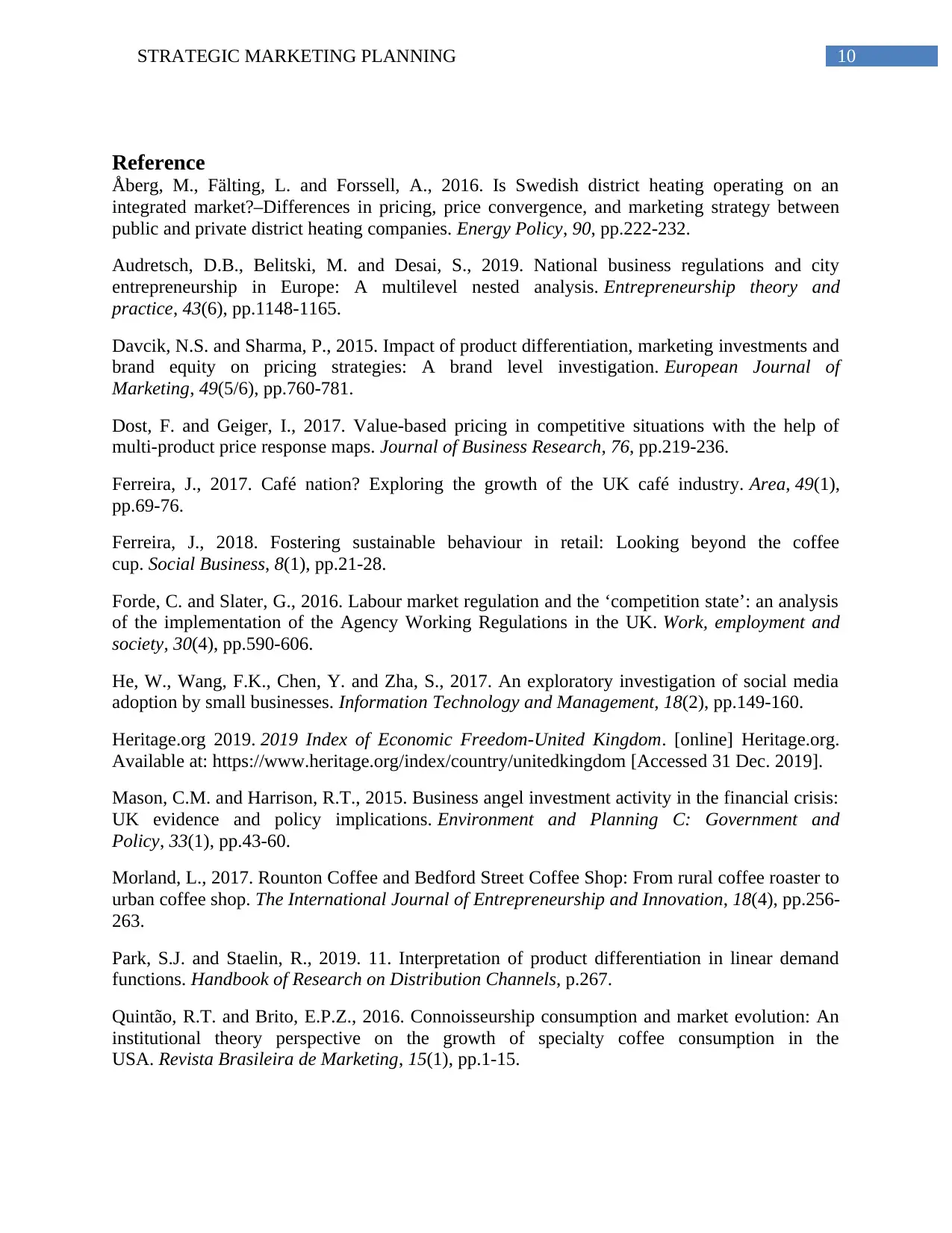
10STRATEGIC MARKETING PLANNING
Reference
Åberg, M., Fälting, L. and Forssell, A., 2016. Is Swedish district heating operating on an
integrated market?–Differences in pricing, price convergence, and marketing strategy between
public and private district heating companies. Energy Policy, 90, pp.222-232.
Audretsch, D.B., Belitski, M. and Desai, S., 2019. National business regulations and city
entrepreneurship in Europe: A multilevel nested analysis. Entrepreneurship theory and
practice, 43(6), pp.1148-1165.
Davcik, N.S. and Sharma, P., 2015. Impact of product differentiation, marketing investments and
brand equity on pricing strategies: A brand level investigation. European Journal of
Marketing, 49(5/6), pp.760-781.
Dost, F. and Geiger, I., 2017. Value-based pricing in competitive situations with the help of
multi-product price response maps. Journal of Business Research, 76, pp.219-236.
Ferreira, J., 2017. Café nation? Exploring the growth of the UK café industry. Area, 49(1),
pp.69-76.
Ferreira, J., 2018. Fostering sustainable behaviour in retail: Looking beyond the coffee
cup. Social Business, 8(1), pp.21-28.
Forde, C. and Slater, G., 2016. Labour market regulation and the ‘competition state’: an analysis
of the implementation of the Agency Working Regulations in the UK. Work, employment and
society, 30(4), pp.590-606.
He, W., Wang, F.K., Chen, Y. and Zha, S., 2017. An exploratory investigation of social media
adoption by small businesses. Information Technology and Management, 18(2), pp.149-160.
Heritage.org 2019. 2019 Index of Economic Freedom-United Kingdom. [online] Heritage.org.
Available at: https://www.heritage.org/index/country/unitedkingdom [Accessed 31 Dec. 2019].
Mason, C.M. and Harrison, R.T., 2015. Business angel investment activity in the financial crisis:
UK evidence and policy implications. Environment and Planning C: Government and
Policy, 33(1), pp.43-60.
Morland, L., 2017. Rounton Coffee and Bedford Street Coffee Shop: From rural coffee roaster to
urban coffee shop. The International Journal of Entrepreneurship and Innovation, 18(4), pp.256-
263.
Park, S.J. and Staelin, R., 2019. 11. Interpretation of product differentiation in linear demand
functions. Handbook of Research on Distribution Channels, p.267.
Quintão, R.T. and Brito, E.P.Z., 2016. Connoisseurship consumption and market evolution: An
institutional theory perspective on the growth of specialty coffee consumption in the
USA. Revista Brasileira de Marketing, 15(1), pp.1-15.
Reference
Åberg, M., Fälting, L. and Forssell, A., 2016. Is Swedish district heating operating on an
integrated market?–Differences in pricing, price convergence, and marketing strategy between
public and private district heating companies. Energy Policy, 90, pp.222-232.
Audretsch, D.B., Belitski, M. and Desai, S., 2019. National business regulations and city
entrepreneurship in Europe: A multilevel nested analysis. Entrepreneurship theory and
practice, 43(6), pp.1148-1165.
Davcik, N.S. and Sharma, P., 2015. Impact of product differentiation, marketing investments and
brand equity on pricing strategies: A brand level investigation. European Journal of
Marketing, 49(5/6), pp.760-781.
Dost, F. and Geiger, I., 2017. Value-based pricing in competitive situations with the help of
multi-product price response maps. Journal of Business Research, 76, pp.219-236.
Ferreira, J., 2017. Café nation? Exploring the growth of the UK café industry. Area, 49(1),
pp.69-76.
Ferreira, J., 2018. Fostering sustainable behaviour in retail: Looking beyond the coffee
cup. Social Business, 8(1), pp.21-28.
Forde, C. and Slater, G., 2016. Labour market regulation and the ‘competition state’: an analysis
of the implementation of the Agency Working Regulations in the UK. Work, employment and
society, 30(4), pp.590-606.
He, W., Wang, F.K., Chen, Y. and Zha, S., 2017. An exploratory investigation of social media
adoption by small businesses. Information Technology and Management, 18(2), pp.149-160.
Heritage.org 2019. 2019 Index of Economic Freedom-United Kingdom. [online] Heritage.org.
Available at: https://www.heritage.org/index/country/unitedkingdom [Accessed 31 Dec. 2019].
Mason, C.M. and Harrison, R.T., 2015. Business angel investment activity in the financial crisis:
UK evidence and policy implications. Environment and Planning C: Government and
Policy, 33(1), pp.43-60.
Morland, L., 2017. Rounton Coffee and Bedford Street Coffee Shop: From rural coffee roaster to
urban coffee shop. The International Journal of Entrepreneurship and Innovation, 18(4), pp.256-
263.
Park, S.J. and Staelin, R., 2019. 11. Interpretation of product differentiation in linear demand
functions. Handbook of Research on Distribution Channels, p.267.
Quintão, R.T. and Brito, E.P.Z., 2016. Connoisseurship consumption and market evolution: An
institutional theory perspective on the growth of specialty coffee consumption in the
USA. Revista Brasileira de Marketing, 15(1), pp.1-15.
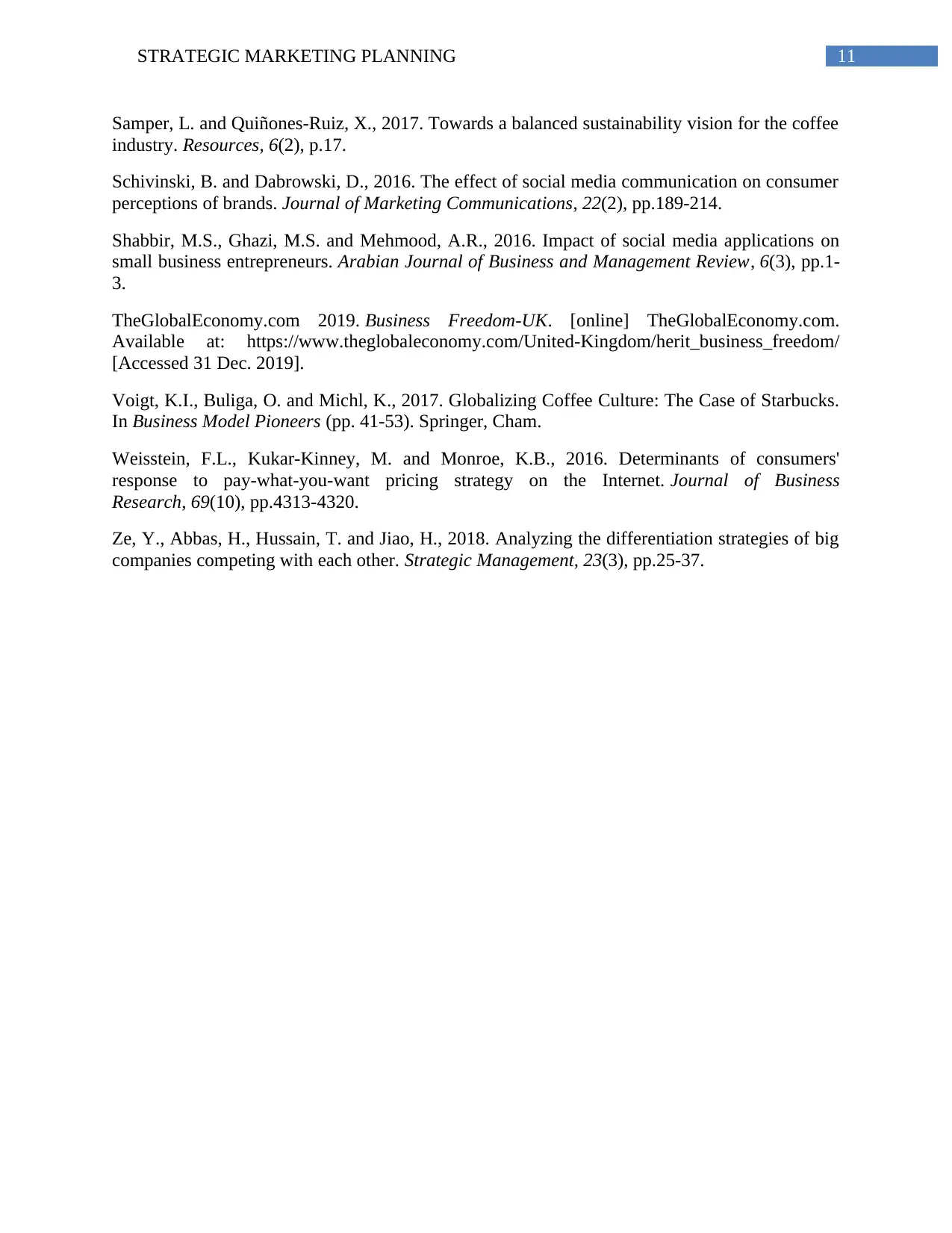
11STRATEGIC MARKETING PLANNING
Samper, L. and Quiñones-Ruiz, X., 2017. Towards a balanced sustainability vision for the coffee
industry. Resources, 6(2), p.17.
Schivinski, B. and Dabrowski, D., 2016. The effect of social media communication on consumer
perceptions of brands. Journal of Marketing Communications, 22(2), pp.189-214.
Shabbir, M.S., Ghazi, M.S. and Mehmood, A.R., 2016. Impact of social media applications on
small business entrepreneurs. Arabian Journal of Business and Management Review, 6(3), pp.1-
3.
TheGlobalEconomy.com 2019. Business Freedom-UK. [online] TheGlobalEconomy.com.
Available at: https://www.theglobaleconomy.com/United-Kingdom/herit_business_freedom/
[Accessed 31 Dec. 2019].
Voigt, K.I., Buliga, O. and Michl, K., 2017. Globalizing Coffee Culture: The Case of Starbucks.
In Business Model Pioneers (pp. 41-53). Springer, Cham.
Weisstein, F.L., Kukar-Kinney, M. and Monroe, K.B., 2016. Determinants of consumers'
response to pay-what-you-want pricing strategy on the Internet. Journal of Business
Research, 69(10), pp.4313-4320.
Ze, Y., Abbas, H., Hussain, T. and Jiao, H., 2018. Analyzing the differentiation strategies of big
companies competing with each other. Strategic Management, 23(3), pp.25-37.
Samper, L. and Quiñones-Ruiz, X., 2017. Towards a balanced sustainability vision for the coffee
industry. Resources, 6(2), p.17.
Schivinski, B. and Dabrowski, D., 2016. The effect of social media communication on consumer
perceptions of brands. Journal of Marketing Communications, 22(2), pp.189-214.
Shabbir, M.S., Ghazi, M.S. and Mehmood, A.R., 2016. Impact of social media applications on
small business entrepreneurs. Arabian Journal of Business and Management Review, 6(3), pp.1-
3.
TheGlobalEconomy.com 2019. Business Freedom-UK. [online] TheGlobalEconomy.com.
Available at: https://www.theglobaleconomy.com/United-Kingdom/herit_business_freedom/
[Accessed 31 Dec. 2019].
Voigt, K.I., Buliga, O. and Michl, K., 2017. Globalizing Coffee Culture: The Case of Starbucks.
In Business Model Pioneers (pp. 41-53). Springer, Cham.
Weisstein, F.L., Kukar-Kinney, M. and Monroe, K.B., 2016. Determinants of consumers'
response to pay-what-you-want pricing strategy on the Internet. Journal of Business
Research, 69(10), pp.4313-4320.
Ze, Y., Abbas, H., Hussain, T. and Jiao, H., 2018. Analyzing the differentiation strategies of big
companies competing with each other. Strategic Management, 23(3), pp.25-37.
⊘ This is a preview!⊘
Do you want full access?
Subscribe today to unlock all pages.

Trusted by 1+ million students worldwide
1 out of 15
Related Documents
Your All-in-One AI-Powered Toolkit for Academic Success.
+13062052269
info@desklib.com
Available 24*7 on WhatsApp / Email
![[object Object]](/_next/static/media/star-bottom.7253800d.svg)
Unlock your academic potential
Copyright © 2020–2025 A2Z Services. All Rights Reserved. Developed and managed by ZUCOL.





